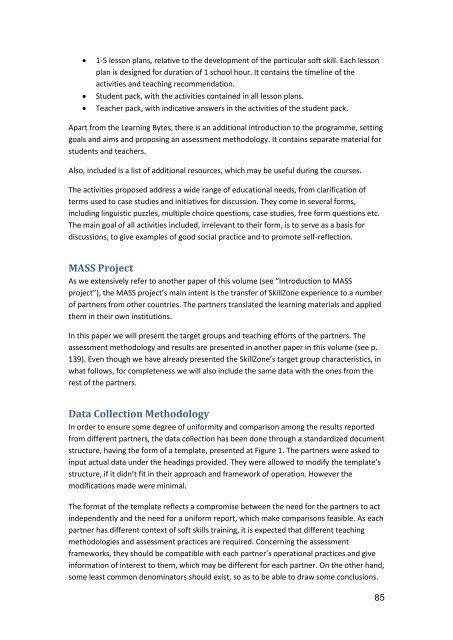Teaching and Assessing Soft Skills - MASS - Measuring and ...
Teaching and Assessing Soft Skills - MASS - Measuring and ...
Teaching and Assessing Soft Skills - MASS - Measuring and ...
Create successful ePaper yourself
Turn your PDF publications into a flip-book with our unique Google optimized e-Paper software.
1-5 lesson plans, relative to the development of the particular soft skill. Each lesson<br />
plan is designed for duration of 1 school hour. It contains the timeline of the<br />
activities <strong>and</strong> teaching recommendation.<br />
Student pack, with the activities contained in all lesson plans.<br />
Teacher pack, with indicative answers in the activities of the student pack.<br />
Apart from the Learning Bytes, there is an additional introduction to the programme, setting<br />
goals <strong>and</strong> aims <strong>and</strong> proposing an assessment methodology. It contains separate material for<br />
students <strong>and</strong> teachers.<br />
Also, included is a list of additional resources, which may be useful during the courses.<br />
The activities proposed address a wide range of educational needs, from clarification of<br />
terms used to case studies <strong>and</strong> initiatives for discussion. They come in several forms,<br />
including linguistic puzzles, multiple choice questions, case studies, free form questions etc.<br />
The main goal of all activities included, irrelevant to their form, is to serve as a basis for<br />
discussions, to give examples of good social practice <strong>and</strong> to promote self-reflection.<br />
<strong>MASS</strong> Project<br />
As we extensively refer to another paper of this volume (see “Introduction to <strong>MASS</strong><br />
project”), the <strong>MASS</strong> project’s main intent is the transfer of SkillZone experience to a number<br />
of partners from other countries. The partners translated the learning materials <strong>and</strong> applied<br />
them in their own institutions.<br />
In this paper we will present the target groups <strong>and</strong> teaching efforts of the partners. The<br />
assessment methodology <strong>and</strong> results are presented in another paper in this volume (see p.<br />
139). Even though we have already presented the SkillZone’s target group characteristics, in<br />
what follows, for completeness we will also include the same data with the ones from the<br />
rest of the partners.<br />
Data Collection Methodology<br />
In order to ensure some degree of uniformity <strong>and</strong> comparison among the results reported<br />
from different partners, the data collection has been done through a st<strong>and</strong>ardized document<br />
structure, having the form of a template, presented at Figure 1. The partners were asked to<br />
input actual data under the headings provided. They were allowed to modify the template’s<br />
structure, if it didn’t fit in their approach <strong>and</strong> framework of operation. However the<br />
modifications made were minimal.<br />
The format of the template reflects a compromise between the need for the partners to act<br />
independently <strong>and</strong> the need for a uniform report, which make comparisons feasible. As each<br />
partner has different context of soft skills training, it is expected that different teaching<br />
methodologies <strong>and</strong> assessment practices are required. Concerning the assessment<br />
frameworks, they should be compatible with each partner’s operational practices <strong>and</strong> give<br />
information of interest to them, which may be different for each partner. On the other h<strong>and</strong>,<br />
some least common denominators should exist, so as to be able to draw some conclusions.<br />
85





